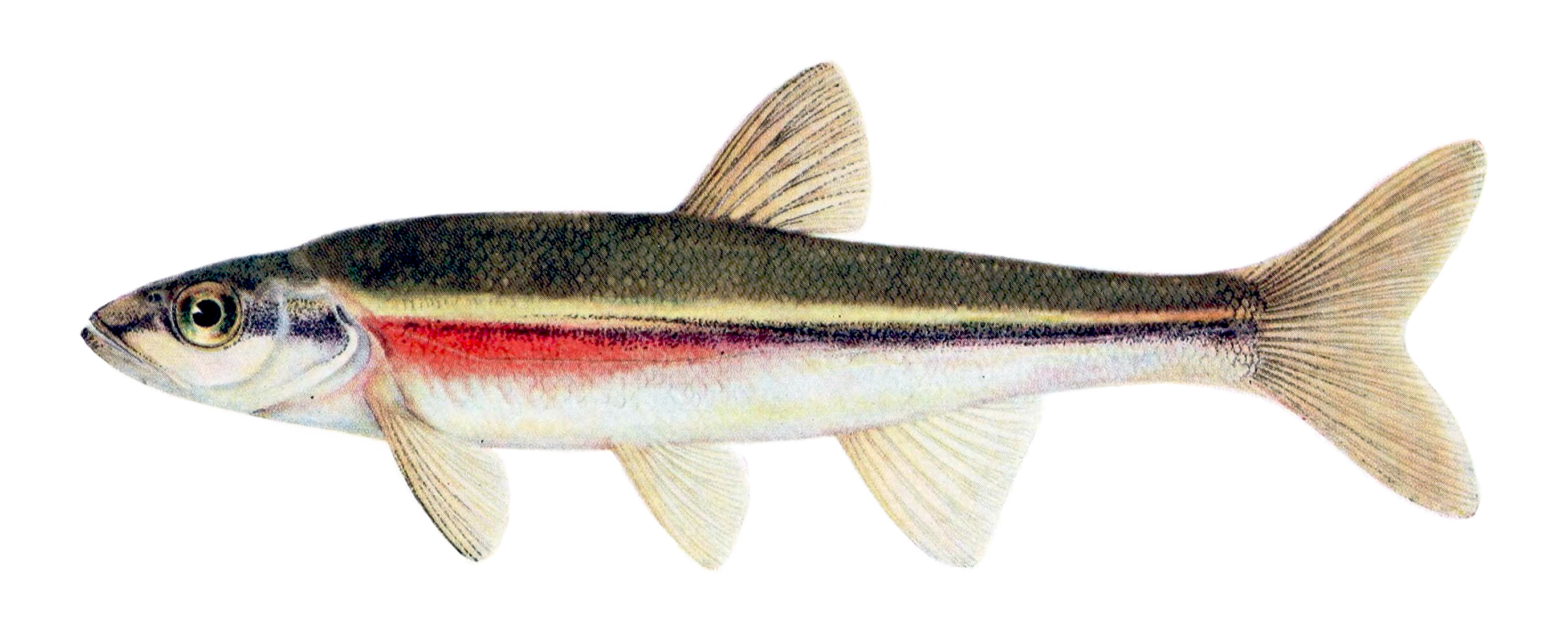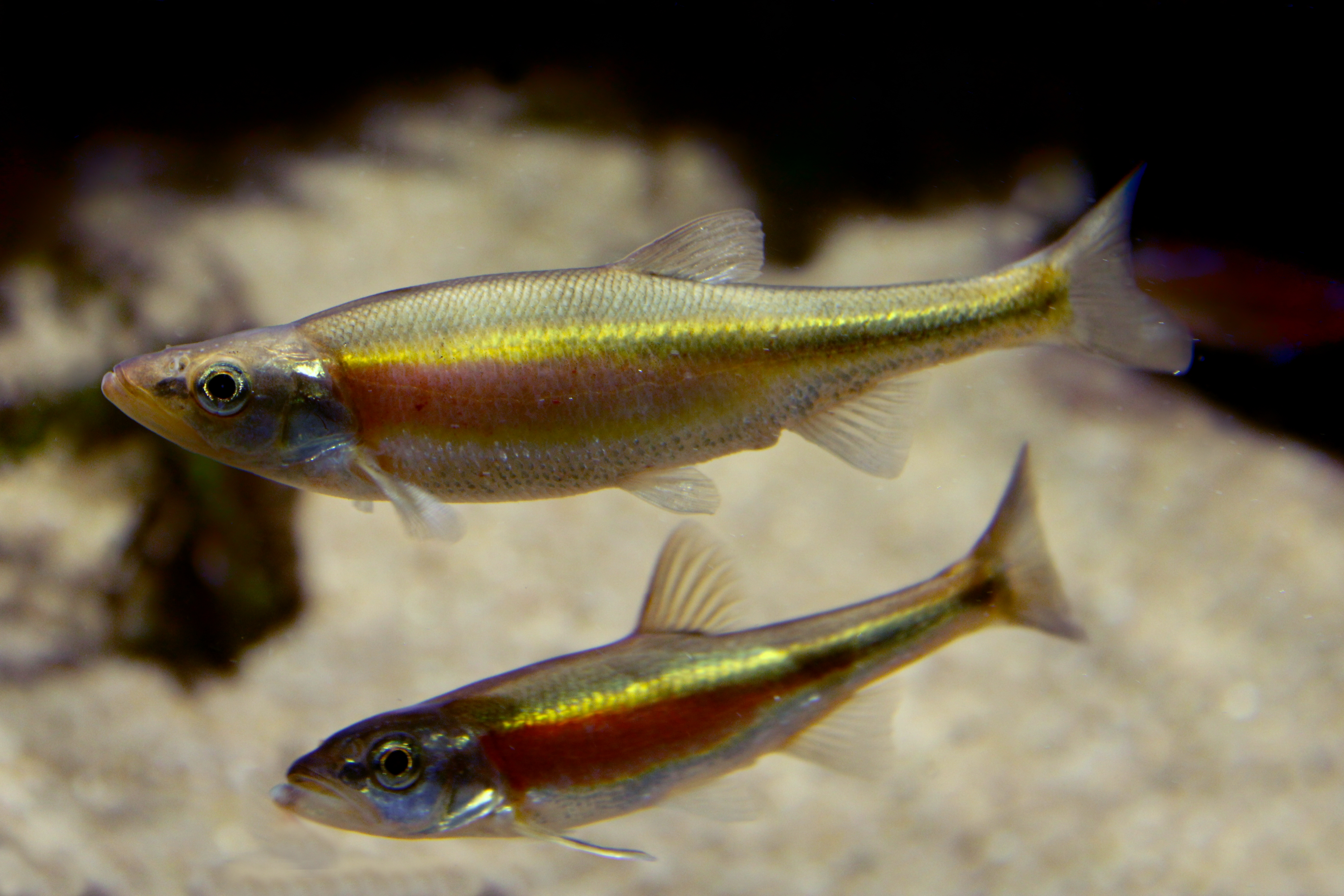Clinostomus Elongatus on:
[Wikipedia]
[Google]
[Amazon]
 The redside dace (''Clinostomus elongatus'') is a species of
The redside dace (''Clinostomus elongatus'') is a species of

 The redside dace (''Clinostomus elongatus'') is a species of
The redside dace (''Clinostomus elongatus'') is a species of ray-finned fish
Actinopterygii (; ), members of which are known as ray-finned fishes, is a class of bony fish. They comprise over 50% of living vertebrate species.
The ray-finned fishes are so called because their fins are webs of skin supported by bony or h ...
in the family Cyprinidae, found in the United States
The United States of America (U.S.A. or USA), commonly known as the United States (U.S. or US) or America, is a country primarily located in North America. It consists of 50 states, a federal district, five major unincorporated territori ...
and Canada
Canada is a country in North America. Its ten provinces and three territories extend from the Atlantic Ocean to the Pacific Ocean and northward into the Arctic Ocean, covering over , making it the world's second-largest country by tot ...
. It is unique among minnow
Minnow is the common name for a number of species of small freshwater fish, belonging to several genera of the families Cyprinidae and Leuciscidae. They are also known in Ireland as pinkeens.
Smaller fish in the subfamily Leusciscidae are c ...
s, being the only species to routinely feed on flying insect
Insects (from Latin ') are pancrustacean hexapod invertebrates of the class Insecta. They are the largest group within the arthropod phylum. Insects have a chitinous exoskeleton, a three-part body ( head, thorax and abdomen), three ...
s by leaping from water. Thus, it acts as a conduit for nutrient transfers between terrestrial and aquatic environments. The species can be used as an ecosystem health
Ecosystem health is a metaphor used to describe the condition of an ecosystem.Rapport, David (1998). "Defining ecosystem health." Pages 18-33 in Rapport, D.J. (ed.) (1998). ''Ecosystem Health.'' Blackwell Scientific. Ecosystem condition can vary ...
indicator, as it is sensitive to environmental disturbances.
Taxonomy
American naturalist Jared Potter Kirtland described the redside dace in 1840.Distribution
United States
The species is most abundant inPennsylvania
Pennsylvania (; ( Pennsylvania Dutch: )), officially the Commonwealth of Pennsylvania, is a state spanning the Mid-Atlantic, Northeastern, Appalachian, and Great Lakes regions of the United States. It borders Delaware to its southeast, ...
, especially in the upper parts of the Susquehanna River drainage. It is also found in the streams of all the Great Lakes
The Great Lakes, also called the Great Lakes of North America, are a series of large interconnected freshwater lakes in the mid-east region of North America that connect to the Atlantic Ocean via the Saint Lawrence River. There are five lak ...
, as well as in the Ohio River and the upper parts of the Mississippi River
The Mississippi River is the second-longest river and chief river of the second-largest drainage system in North America, second only to the Hudson Bay drainage system. From its traditional source of Lake Itasca in northern Minnesota, it fl ...
drainage.

Canada
The distribution of redside dace is mainly limited toSouthern Ontario
Southern Ontario is a primary region of the province of Ontario, Canada, the other primary region being Northern Ontario. It is the most densely populated and southernmost region in Canada. The exact northern boundary of Southern Ontario is disp ...
, the Two Tree River on the St. Joseph Island being the only exception. Most populations have been identified in the streams draining into the western part of Lake Ontario
Lake Ontario is one of the five Great Lakes of North America. It is bounded on the north, west, and southwest by the Canadian province of Ontario, and on the south and east by the U.S. state of New York. The Canada–United States border ...
, from the Pringle Creek near Oshawa to the Spencer Creek near Hamilton, Ontario
Hamilton is a port city in the Canadian Provinces and territories of Canada, province of Ontario. Hamilton has a Canada 2016 Census, population of 569,353, and its Census Metropolitan Area, census metropolitan area, which includes Burlington, ...
. Smaller populations exist in the drainages of Lake Simcoe
Lake Simcoe is a lake in southern Ontario, Canada, the fourth-largest lake wholly in the province, after Lake Nipigon, Lac Seul, and Lake Nipissing. At the time of the first European contact in the 17th century the lake was called ''Ouentironk' ...
(Holland River
The Holland River is a river in Ontario, Canada, that drains the Holland River watershed into Cook's Bay, the southern extremity of Lake Simcoe. The river flows generally north, and its headwaters lie in the Oak Ridges Moraine. The Holland Riv ...
system), Lake Erie
Lake Erie ( "eerie") is the fourth largest lake by surface area of the five Great Lakes in North America and the eleventh-largest globally. It is the southernmost, shallowest, and smallest by volume of the Great Lakes and therefore also h ...
(Irvine Creek), Berczy Creek Berczy may refer to:
* William Berczy, founder of Berczy Village in Upper Canada
*William Bent Berczy, a farmer, painter and political figure in Upper Canada
*Charles Albert Berczy
* Berczy Village, Ontario, the original settlement that grew to beco ...
in Markham Markham may refer to:
It may also refer to brand of of clothing which originates from South Africa which saw it's establishment in 1873.
Biology
* Markham's storm-petrel (''Oceanodroma markhami''), a seabird species found in Chile and Colombia
* ...
and Lake Huron (Saugeen River
The Saugeen River is located in southern Ontario, Canada. The river begins in the Osprey Wetland Conservation Lands and flows generally north-west about before exiting into Lake Huron. The river is navigable for some distance, and was once an im ...
system).
Description
The redside dace is brightly coloured, with a wide red stripe extending from the head to thedorsal fin
A dorsal fin is a fin located on the back of most marine and freshwater vertebrates within various taxa of the animal kingdom. Many species of animals possessing dorsal fins are not particularly closely related to each other, though through c ...
, running along the middle of the body. Above it, a bright yellow stripe extends from head to tail. Colours are the brightest during spring, gradually fading during late summer and fall. Distinguishing it from other cyprinids, the species has a very large mouth and protruding lower jaw, which is an effective adaptation for capturing prey from below. The species' maximum length is 12 cm. The lifespan is no longer than four years.
It has longer and more slender body with brighter red coloration on its sides than the similar rosyside dace.
Habitat
The species favours slow-moving, cool, and clearheadwaters
The headwaters of a river or stream is the farthest place in that river or stream from its estuary or downstream confluence with another river, as measured along the course of the river. It is also known as a river's source.
Definition
The ...
of river systems, with copious overhanging riparian
A riparian zone or riparian area is the interface between land and a river or stream. Riparian is also the proper nomenclature for one of the terrestrial biomes of the Earth. Plant habitats and communities along the river margins and banks a ...
vegetation, especially grasses, forb
A forb or phorb is an herbaceous flowering plant that is not a graminoid (grass, sedge, or rush). The term is used in biology and in vegetation ecology, especially in relation to grasslands and understory. Typically these are dicots without woo ...
s, and low shrubs. A preferred stream features a succession of riffle
A riffle is a shallow landform in a flowing channel. Colloquially, it is a shallow place in a river where water flows quickly past rocks. However, in geology a riffle has specific characteristics.
Topographic, sedimentary and hydraulic indica ...
s, necessary for spawning
Spawn is the eggs and sperm released or deposited into water by aquatic animals. As a verb, ''to spawn'' refers to the process of releasing the eggs and sperm, and the act of both sexes is called spawning. Most aquatic animals, except for aquat ...
, and pools, inhabited outside the breeding season.
Conservation status
Although globally secure, the species has dwindled in many areas of its range; some populations have been extirpated. The redside dace is listed as endangered inIndiana
Indiana () is a U.S. state in the Midwestern United States. It is the 38th-largest by area and the 17th-most populous of the 50 States. Its capital and largest city is Indianapolis. Indiana was admitted to the United States as the 19th s ...
and as of February 20, 2009, also in Ontario
Ontario ( ; ) is one of the thirteen provinces and territories of Canada.Ontario is located in the geographic eastern half of Canada, but it has historically and politically been considered to be part of Central Canada. Located in Central C ...
, as threatened in Michigan
Michigan () is a U.S. state, state in the Great Lakes region, Great Lakes region of the Upper Midwest, upper Midwestern United States. With a population of nearly 10.12 million and an area of nearly , Michigan is the List of U.S. states and ...
, and as special concern in Wisconsin
Wisconsin () is a state in the upper Midwestern United States. Wisconsin is the 25th-largest state by total area and the 20th-most populous. It is bordered by Minnesota to the west, Iowa to the southwest, Illinois to the south, Lake M ...
. The Committee on the Status of Endangered Wildlife in Canada
The Committee on the Status of Endangered Wildlife in Canada (COSEWIC, French: Comité sur la situation des espèces en péril au Canada, COSEPAC) is an independent committee of wildlife experts and scientists whose "raison d'être is to identify s ...
lists it as endangered.
References
{{Taxonbar, from=Q3499950 Clinostomus Taxa named by Jared Potter Kirtland Fish described in 1840 Freshwater fish of North America